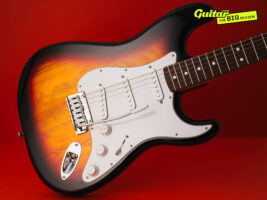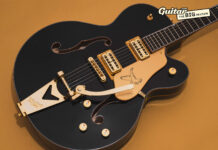
Fender Standard Stratocaster review – “I can’t shake the feeling it should be better than this”
$599/£499, fender.com
Let me kick this review off with a little anecdote. A few years back I was at a thing, chatting with the owner of a well-known guitar shop. We ended up talking about Fender’s quest to seemingly create every guitar-related product known to man – pedals, power supplies, strings, patch cables and on and on. In the course of our chat I wondered what Fender was really getting out of having products in sectors where existing brands seemingly had long-term market dominance. The retailer revealed something that’s stuck with me ever since: that whenever Fender released a new product, it would instantly become one of the best-sellers in that category. That, friends, is the power of the Fender brand.
READ MORE: Fender American Ultra II Stratocaster review – the shreddiest Strat ever?
Which brings us to the Standard Series – a new line of guitars that by their very existence have caused quite a stir. That’s because these guitars might say Fender on them, but they aren’t made in either the USA or Mexico, but Indonesia.
Of course, this isn’t the first time Fender has made guitars in Asia – Squiers have always been made there, as have Fender’s acoustics, while a decade or so back they made a bunch of oddball electrics in China called the Modern Player. More recently, the Tom DeLonge Starcaster was made in Indonesia, with impressive results.
Our model is made of five pieces of dense poplar – and it weighs a ton (Photo: Adam Gasson/Guitar.com)
Still, sticking Fender badge on a guitar made outside of Corona or Ensenada feels like a big moment – especially as the Standard Series is much more vanilla than the Modern Player range, comprising the biggest hitters in traditional configurations – SSS and HSS Strats, a Telecaster, and Jazz and P Basses – and with pretty unassuming visuals. The question begs then, are these anything more than rebadged Squiers?
Fender Standard Stratocaster – what is it?
For a clue as to why this guitar and the rest of the Standard range exists, let me take you to a ballroom at the Anaheim Convention Center back in January. It’s here at the annual NAMM show’s 2025 Media Preview event that Fender unveils the Standard Series, and where Fender’s EVP of Product Justin Norvell was remarkably candid about their motivation for adding this range.
The headstock has a gloss front in contrast to the satin back – something that Fender also did on the Player II guitars (Photo: Adam Gasson/Guitar.com)
Using a pyramid chart that listed every Fender range from the cheapest Squiers all the way up to Custom Shop, you could see Fender guitars slotted in at pretty much every price point… except one. Thanks to the upgrades to the (exceptionally good) Player II range nudging the price of that line up, there was now a considerable gap between the bottom of Mexico-made Fender and the top end of Squier. What’s more, Norvell revealed that Fender research claimed that a whopping 12% of guitars that are sold are in this $5-600 price point.
As discussed up top, Fender abhors a vacuum almost as much as Aristotle, and so into that gap goes the Standard Series. You can be cynical about that if you wish, but it’s evident that there are people out there who want to buy a Fender guitar for about $600. In fact, I’d bet that you may well have bought your first Fender at this price point back in the days before eggs cost five bucks for a dozen – it’s hardly Fender’s fault for finding a way to cater to that market.
There’s also a fair bit of pretty grimly-undertoned hostility to the idea that a guitar made in Asia is going to be inferior to one made in the US or Mexico. PRS’s SE line is made in Indonesia by Cor-Tek, just like the Standards, and they’re some of the very best guitars you can get for non-silly money these days.
Squier’s Classic Vibe range is also seriously good for the money, and you can throw in Gretsch’s Electromatics and a laundry list of other brands who are making top-notch guitars in Asia. All of which is to say that just because this guitar is made in Indonesia does not automatically mean it’s worse than a Mexico-made guitar.
The two-point modern vibrato has block saddles, and comes set up at quite a sharp angle (Photo: Adam Gasson/Guitar.com)
Indeed, on the surface this Strat seems to tick all the boxes of what you’d want from your First Real Strat – you get the classic Strat body with a trio of single-coils, a two-point modern floating vibrato, and a matt-finished maple neck with laurel fingerboard. The body is poplar as opposed to alder – a more affordable wood than what is usually seen on a Fender guitar, but one that at least has similar sonic qualities. Here we have a Three-colour Sunburst example, but it’s also available in very handsome Aqua Marine Metallic, as well as Olympic White and Candy Cola (a deeper shade of red) with maple necks.
Fender Standard Stratocaster – build quality and playability
I said above that a guitar being made in Asia had absolutely no bearing on its overall quality, but making something to a cost primarily often does. I’m struck by that sensation upon heaving the Standard Strat out of its box – and I mean heave, because this thing tips the scales at over 9lbs.
That’s pushing this Strat into Les Paul territory weight-wise – not exactly something that you’d want to sling over your shoulder for a long sweaty set. This is not an isolated incident either – I played several Standards at Fender’s booth at NAMM and they were all noticeably weighty.
The mineral staining in the poplar leads to some ‘interesting’ grain patterns (Photo: Adam Gasson/Guitar.com)
The transparent nature of the Sunburst finish doesn’t exactly reassure either – we’re used to affordable Fender bodies being made of multiple pieces (hell, back in the 90s Mexico-made Fender were sometimes made of veneer-covered eight-piece bodies) but the Standard’s five-piece does not wear it well.
Part of this is probably down to wood choice – poplar is a soft and dense wood that is prone to mineral stains, and that’s very evident here as you can see hues of green and blue in the yellow of the Sunburst – it’s something accentuated by a very thick gloss finish. If the wood grain is going to bother you, I’d steer clear of the ‘burst and get one of the lovely solid colours instead.
A curious quirk of Fender factory vibrato set-ups is that they’re usually set floating a few millimetres above the horizontal to give you both up and down travel. Some people hate this of course, but it’s not wrong, even if it sometimes looks like it. The Standard however, takes this to uncomfortable extremes – the vibrato is floating pretty much half a centimeter off the horizontal, with the heights of block saddles (which are matt-finished for no real reason) set extremely high to compensate.
It doesn’t really compromise the feel, but the tuning stability is not where I’d expect it to be. Compared to even the Squier Sonic Strat I reviewed a few years back, the guitar struggles to stay in tune after a session of rigorous bending, and while the vibrato does return to pitch the first few times, it doesn’t take much for it to start drifting.
The fingerboard is laurel – a wood we’re used to seeing as a rosewood substitute on Epiphone and Gretsch guitars (Photo: Adam Gasson/Guitar.com)
All of this could be easily fixed with a set-up of course (and candidly, within about half an hour the strings are off, the vibrato claw is tightened, and the thing is behaving much more predictably) but you don’t expect a Fender guitar to need a trip to a tech straight out of the box – even at this price point.
One thing I can’t fault is the overall playability – the Modern C neck profile is comfortable (though a little shallower than the Player II’s supposedly identical carve), the medium-jumbo frets are nicely polished, and I have to tip my hat again to whomever it is at Fender who worked out how to roll their fingerboard edges in a cost-effective way. It’s not quite as pronounced as on the Player II guitars, but there’s a nice softening of the transition here that really enhances the overall comfort.
Fender Standard Stratocaster – sounds
The pickups are higher output than a usual Strat’s and that’s by design (Photo: Adam Gasson/Guitar.com)
I’ve reviewed a lot of Strat-type guitars over the years, and to be quite honest with you I sometimes dread getting to the sounds part of the review, because I know that I’m going to have to contrive yet another way to spend a few hundred words explaining that yes, it sounds like a Stratocaster.
Except, with the Standard Strat that’s not quite as clear cut. You see, the pickups in this guitar are not your traditional Alnico-magneted single-coils, but higher-output ceramic units. Instantly that puts you in quite a different sonic territory than your regular Stratocaster – a more strident and punchy sound with a tight low-end. On the neck and middle positions it’s not un-Strat-like, with plenty of glassiness in the highs, but with a real midrange body, and not a lot of the ‘honk’ some people would prefer from a classic Strat sound in the in-between positions. It’s very usable however, and takes gain very well.
The bridge pickup however, is not so easy to recommend – here that extra output quickly lends itself to a nasal tonality that’s downright unpleasant, and while you can take the edge off it with the tone control (it mercifully has the non-traditional wiring arrangement), it’s still quite harsh and hairy. Some will like the brattiness of it of course, and it certainly has more about it when you add a fair chunk of gain, but it’s not going to be for everyone.
Fender Standard Stratocaster – should I buy one?
The Standard has Fender’s modern Strat wiring, meaning the second tone control is for the bridge pickup (Photo: Adam Gasson/Guitar.com)
Since they launched, there’s been a lot of sniffy comments about how these guitars are ‘rebadged Squiers’ as if that would be a bad thing. The best of Squier’s Classic Vibe instruments can go toe-to-toe with Mexico in terms of looks, playability and sounds – if Fender had simply slapped a Fender logo on a CV instrument and charged another 100 bucks for it, the score at the top of this review would likely have had another point or two on it. Instead, we have a guitar that feels a little underwhelming – perhaps not surprising given its stated aim as a rung-filler on Fender’s product ladder.
This isn’t a bad instrument at all, and I imagine that plenty of young players will enjoy these guitars on their own merits, and appreciate the accessibility (if not the weight here) of once again being able to get a guitar with Fender on the headstock for under $600 – the power of that brand cannot be understated. But ultimately, I can’t shake the feeling that this guitar could – and perhaps should – have been better and more inspiring than this.
Fender Standard Stratocaster – alternatives
The neck is maple with lightly rolled fingerboard edges – a nice touch (Photo: Adam Gasson/Guitar.com)
There is an almost comically large number of options for Strats and S-types in and around this price point. If you’re considering a Standard Strat and the headstock logo isn’t the be all and end all, I’d be inclined to recommend you save yourself a hundred bucks or so and score yourself a Squier Classic Vibe ‘60s Strat ($429/£379) – it’s arguably a better, and certainly more classically Fender, instrument. If it has to be Fender, I’d honestly recommend saving up another couple of hundred dollars and grab yourself the sensational Player II Stratocaster ($799/£709). If you want a Fender-styled instrument that offers plenty of bang for buck, the Sire Larry Carlton S7 Vintage ($641/£449) is a compelling option.
The post Fender Standard Stratocaster review – “I can’t shake the feeling it should be better than this” appeared first on Guitar.com | All Things Guitar.
Source: www.guitar-bass.net











